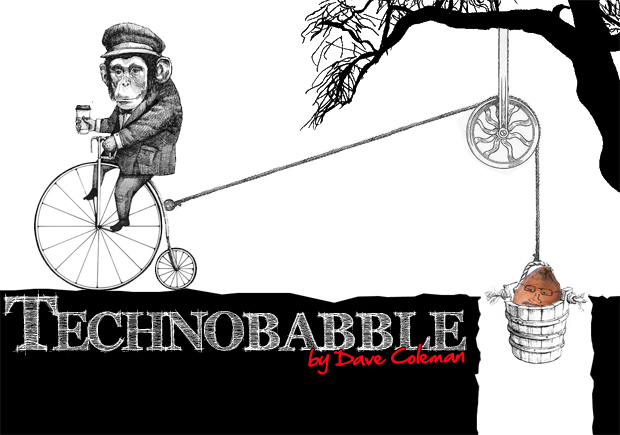
Technobabble
Monkeypower Redefined
by Dave Coleman
In my continuing quest to right the wrongs of the modern automotive world, I hereby propose the retirement of the horsepower. Why? Simple. Horsepower, as a measurement of engine output, is a bizarrely arbitrary unit of measure. If the history books are right, a horsepower is supposedly 1.5 times the amount of work an average mine pony could do, as measured sometime in the late 1700s. This is stupid.
Supposedly a late 1700s horse could do 22,000 foot-pounds of work every minute. Basically, that means if you tied a 220-pound bucket of coal to the backside of a horse, it could drag the bucket 100 feet up a mine shaft in a minute. Or it could drag 2200 pounds 10 feet up the shaft. Or, with the right gearing (block and tackle in those days), even 22,000 pounds one foot up the shaft. You get the idea.
So along comes James Watt, who must have been pretty smart, since he managed to get his name on every lightbulb ever made, and decides one horsepower should be defined as 33,000 foot-pounds per minute.
What?
A horse can do 22,000, but a horsepower is 33,000? Perhaps James Watt was visionary enough to build this in as a hedge against exaggerated horsepower claims.
Automotive terms and definitions have a long history of being stupid and arbitrary, and I have no intention of changing that, but if we’re going to be stupid, let’s at least use monkeys. So, monkeypower it is, then. We’ll start with an average monkey: Josh Jacquot.
Despite the fact that Jacquot claims to be a highly advanced form of monkey, he throws an absolute fit if you try to tie a rope to his backside and drop said rope down a mineshaft with 220 pounds of coal on the other end of it. Party pooper.
So instead of coal, let’s define monkeypower with mountain bikes. In racing trim, a Jacquot monkey is 124 pounds of unmitigated fury. His monkey bike weighs 21.25 pounds. A bottle of monkey water, some monkey tools, and a spare monkey innertube add up to another pound. Total: 146.25 pounds. According to actual data logs, Jacquot can climb 3000 vertical feet in one hour. That’s 50 feet per minute, or 7312.5 foot-pounds per minute. Of course, we still have that arbitrary factor of 1.5 to throw in to compensate for monkeypower escalation. Throw in the factor and the official definition of a monkeypower is 10,968.75 pound-feet per minute. Or 0.332 horsepower.
This is the monkeypower definition I put forth in the February, 2004 issue of Sport Copmact Car, but as with much of what we published back then, a few years of reflection have called that original calculation into question. Simple observation of a monkey suggests it can't do one third the work of a horse, and, indeed, if you try a couple thought experiments, you'll quickly see this conversion factor is highly improbable. A good rider, for example, can travel 50 miles on a horse in one day, but there's no way I could ride Josh for more than about half a mile. Even accounting for my shortage of riding skills, we clearly need to adjust the math.
The problem, it turns out, is that Josh's refusal to haul buckets of coal led us to an erroneous substitution. We calculated the weight of Josh and his monkey bike, but when when Watt's horse dragged that 220-pound bucket, he ignored the 1200 pounds of horse that was also moving. So, to be fair, we should cancel out the monkey meat. Doing that leaves us only with 22.25 pounds of bike, water and tools, and when you re-do the math with that figure, one monkeypower is only 0.05 hp.
Now you see why they don’t use monkeys in coal mines.
So, did you catch the point of this story? It was up in the beginning. 22,000 foot pounds per minute can be 22,000 pounds going one foot in one minute, or 2.2 pounds going 10,000 feet in one minute, or anything in between. Know what the difference is? You guessed it. Torque.
That 22,000 pound job took one torquey horse. And the reason the torquey horse and the high-revving horse (that’s the one that only lifted 2.2 pounds) can do the same work is the magic of gearing. A Clydesdale could do all 22,000 foot pounds per minute just by grunting forward a few feet. To get the most out of that kind of horse, you'd want tall gearing that moved the bucket a bunch with only a little horse stepping.
A Thoroughbred, on the other hand, is only at its best in a sprint, so you'd want really short gearing that let the horse cover some distance while lifting the same 22,000 foot pounds per minute. Both horses are making one horsepower, each is just doing it with its own style.
So the only difference between the 3,460-monkeypower / 99 lb-ft Hayabusa engine going into the Miatabusa and the 3,460-monkeypower / 295 lb-ft 2.2-liter turbodiesel in a European market Mazda CX-7 is the style. The gearing required to make each of those engines deliver that monkeypower in a reasonable speed range will have them delivering their monkeypower in a very similar way, but the spinny bits under the Miatabusa's hood will be spinning three times as fast, and sounding three times as good.



